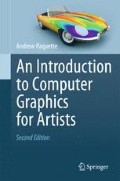Abstract
Linear perspective demonstrated that a realistic representation of a 3D environment could be calculated based on rules that govern how our eyes see the world around us. Because these rules could be written down and they worked, artists were able to replicate the results Alberti described, and linear perspective became a standard tool for artists to the present day. This and other contributions by artists led to what we now recognize as the modern CG industry.
Access this chapter
Tax calculation will be finalised at checkout
Purchases are for personal use only
References
Alexander, P. A. (2003). The development of expertise: The journey from acclimation to proficiency. Educational Researcher, 32(8), 10–14.
Birren, F. (1976). Color perception in art: Beyond the eye into the brain. Leonardo, 9(2), 105–110.
Farago, C. J. (1994). Leonardo’s Battle of Anghiari: A study in the exchange between theory and practice. The Art Bulletin, 76(2), 301–330.
Field, J. V. (1985). Giovanni Battista Benedetti on the mathematics of linear perspective. Journal of the Warburg and Courtauld Institutes, 48, 71–99.
Gage, J. (1987). The technique of Seurat: A reappraisal. The Art Bulletin, 69(3), 448–454.
Hayes, B. (1999). Computing science seeing between the pixels. American Scientist, 87(3), 202–207.
Heffernan, J. A. W. (1996). Alberti on Apelles: Word and image in “De Pictura”. International Journal of the Classical Tradition, 2(3), 345–359.
King, R., et al. (2008). Bridging the gap between education and professional production. SIGGRAPH Asia 2008, Singapore.
Kozbelt, A. (2006). Psychological implications of the history of realistic depiction: Ancient Greece, renaissance Italy and CGI. Leonardo, 39(2), 139–144.
Lee, A. (1981). A critical account of some of Josef Albers’ concepts of color. Leonardo, 14(2), 99–105.
Pottman, H., et al. (2007). Architectural geometry. Exton: The Bentley Press.
Reggini, H. C. (1975). Perspective using curved projection rays and its computer application. Leonardo, 8(4), 307–312.
Shannon, S. (1995). The chrome age: Dawn of virtual reality. Leonardo, 28(5), 369–380.
Sternberg, R. J. (2003). What is an “expert student?”. Educational Researcher, 32(8), 5–9.
White, J. (1949). Developments in renaissance perspective: I. Journal of the Warburg and Courtauld Institutes, 12, 58–79.
Author information
Authors and Affiliations
Rights and permissions
Copyright information
© 2013 Springer-Verlag London
About this chapter
Cite this chapter
Paquette, A. (2013). Introduction. In: An Introduction to Computer Graphics for Artists. Springer, London. https://doi.org/10.1007/978-1-4471-5100-5_1
Download citation
DOI: https://doi.org/10.1007/978-1-4471-5100-5_1
Published:
Publisher Name: Springer, London
Print ISBN: 978-1-4471-5099-2
Online ISBN: 978-1-4471-5100-5
eBook Packages: Computer ScienceComputer Science (R0)

